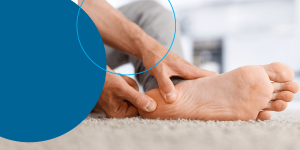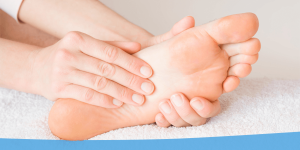People with diabetes should check their feet daily, even if they seem all right, and visit their doctor if they have a blister or cut that won’t go away.
Having diabetes adds much admin to people’s daily routines. People with diabetes must regularly monitor their blood sugar, eat healthy meals, find time to exercise, take medications and attend regular doctor’s appointments. But one thing many sometimes forget to do is check their feet. With so much else to do, it’s understandable. However, people with diabetes frequently experience foot issues, and the best way to avoid foot issues is by maintaining daily foot care.
It can be a little tricky knowing whether your foot problems are the result of diabetes or perhaps a skin disorder like eczema. So here are a few tips on how to know if you have foot problems from diabetes.

How Diabetes Can Impact Your Feet
Before we go into the signs of diabetic feet, it’s important to understand how diabetes can impact your feet. High blood sugar levels can damage the arteries and nerves in the foot. Diabetic neuropathy, the term for nerve damage, can make your feet numb, tingly or painful. If you can’t feel your feet at all, you could have a blister, cut or open sore and not know about it. These wounds can easily get infected, and reduced blood flow can prevent the wound from healing properly.
Gangrene can develop due to an infection and insufficient blood flow. Consequently, the muscle, skin and other tissues begin to deteriorate. If you have gangrene or an ulcer that isn’t improving, it may be necessary to amputate your toe, foot or leg to save your life and prevent the infection from spreading. Fortunately, you can take several preventative measures for diabetic feet to keep a foot wound from developing into a serious medical issue.
Know the Signs of Diabetic Feet
It is crucial to recognize the early symptoms of potential foot issues. These problems can affect anyone, but people with diabetes are more likely to encounter severe complications because of their tendency for poor blood flow and circulation. Some of the signs of diabetic feet include the following:
- Blisters
- Ingrown nails
- Athlete’s foot
- Tingling in the toes
- Slow healing wounds
- Alteration in skin tone
- Sensory loss in the feet
- Hammertoes and bunions
- Swelling in the feet or legs
- Crevices between the toes
- Hair loss on the legs or toes
- Planters warts, corns and calluses
If you experience any of these symptoms, call your doctor immediately. Any delay could significantly increase your chance of additional health problems and difficulties.
How to Prevent Diabetic Foot Problems
Diabetes is the leading cause of non-traumatic lower extremity amputations in the U.S. However, you can take steps to prevent severe diabetic foot problems from developing, including the following:
- Wash your feet daily: Use warm water, not hot, and don’t let your feet soak. Rub moisturizer into the tops and bottoms of dry feet, but avoid the space between the toes, as this could cause an infection.
- Examine your feet: Inspect your feet daily for any changes to your nails or skin. Look for cuts, redness, swelling, ulcers, blisters, corns and calluses. If you have trouble seeing your feet, try using a mirror or asking a family member for help.
- Trim your toenails regularly: Cut them straight across, then gently file any jagged edges. Ask your podiatrist to cut your toenails if you can’t see or reach your feet.
- Avoid walking barefoot: To prevent injuries, remember to wear shoes or slippers. Inspect your shoes to ensure the lining is intact and smooth and there are no stones or other things inside.
- Wear comfortable shoes: It’s best to try new shoes later in the day. Feet are generally larger at the end of the day, so you’ll get the best fit if you wait. Wear new shoes for one or two hours at a time, gradually breaking them in until they are comfortable. Always remember to wear socks when wearing shoes.
- Get someone else to remove any corns and calluses: You shouldn’t attempt to clear these yourself. Also, avoid using over-the-counter solutions as they could cause skin burns.
- Have your doctor examine your feet every time you visit: Whenever you see your primary care physician, ask them to check your feet. You’ll also want to visit a foot doctor annually, though you may need to go more frequently if you have nerve loss. During these appointments, the doctor will assess your feet for blood flow and sensation.
- Keep your blood pumping: When you’re sitting, raise your feet and spend several minutes wriggling your toes regularly during the day.
- Pick foot-friendly exercises: Exercises like biking, swimming and walking are great for getting the blood flowing to your feet. Ask your doctor which activities are better for you and which ones to avoid.
When to See a Doctor
Visit your primary care physician or podiatrist immediately if you encounter any of the following signs:
- Yellow, thick toenails
- Cracked and dry skin
- Fungal infections like athlete’s foot
- A burning or tingling sensation in your feet
- Hair loss of hair on your legs, feet and toes
- An ingrown toenail, corn, blister, sore or ulcer
- A gradual alteration in how your feet are shaped
- A change in the temperature or color of your feet
- Loss of touch sensitivity or a weak capacity to feel cold or heat
- Cramping or pain in your calves, thighs or buttocks, especially during physical exertion
Most people with diabetes can avoid serious foot issues with proper diabetic foot treatment. Your best option for preventing serious problems is to take regular care of your feet at home and attend doctor appointments to avoid minor issues from becoming severe.
Contact Foot & Ankle Surgical Associates for Diabetic Feet
Always visit a doctor if you have any recurrent foot problems. Mild cases may typically be treated at home, but if the treatments are ineffective or the issue is more serious, visit a specialist to get a diagnosis. At Foot & Ankle Surgical Associates, we can assist you in managing and treating your diabetic feet symptoms by offering you the best care. Our knowledgeable staff will determine your health requirements and provide the treatment you need to help you perform at your peak. For an appointment, call us at 360-754-3338 or fill out our form. We’d love to talk to you about your concerns.





